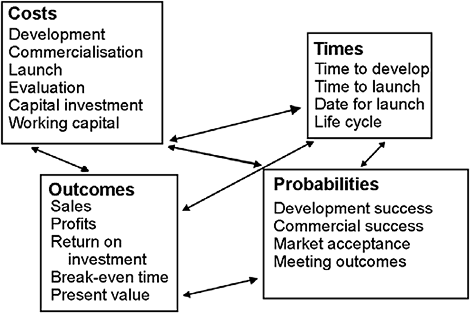FOOD
PRODUCT DEVELOPMENT
Mary Earle, Richard Earle and Allan Anderson |
| Loading
|
|
||||
|
|
Part 2, Chapter 2
Developing an innovation strategy 2.4.4 Quantitative analysis of most suitable strategies
After ranking, the innovation strategies that could lead to success are identified. Now the predicted outcomes and inputs need to be more detailed. Usually this means more financial analysis and determination of the probabilities of achieving these outcomes. A range of predicted sales revenues and the related costs of development and launching the innovation, need to be determined so that possible outcomes such as break-even times, return on investment (ROI), present values, can be analysed. The sales revenues and profits can be predicted for 3-5 years or the life of the innovation. Some important outcomes and costs, and their relationships to probabilities of success and project timing are shown in Fig.
2.10.
 Fig. 2.10 Quantitative analysis of innovation strategies. Increasing the money spent on the project can reduce the times and may increase the sales revenues and the probability of success, so it is important to make predictions on these inter-relationships. The pipeline timing for the innovations needs to be predicted to ensure there is a flow of innovations throughout the future years and that innovations are not jumbled for both timing and resources. There is a need to predict the resources needed for the innovations: raw materials, plant, equipment and distribution system; but most important are the human resources. There is a need to predict the skills and knowledge needed for the innovation and to relate this to the skills and knowledge available in the company. If they are not available, how can they be met? It is surprising how little consideration has been taken of this in recent years - much knowledge and skills have been lost permanently and it is difficult to find new skills and knowledge. In the middle of the last century, there was a philosophy to keep the experienced people going a little longer as you bring in the new people, gradually absorbing the old knowledge and skills into the new minds as well as acquiring new skills from outside. For example, one salt manufacturing company, in changing from processing in open salt pans and marketing salt bricks and sticky crystalline salt, to triple-effect evaporators and free-flow salt, kept both going side-by-side so that the old operators and their customers were kept as the new customers and operators developed. There was only one problem - marketing sold the new salt to stall holders in the markets in West Africa; they still wanted the old sticky salt because peaks of salt could be formed in the tin cans used to measure salt for sale! This was an important selling point. So research had to start again - on making the running salt into sticky salt! To sum up, it is important that the innovation portfolio:  is balanced in levels of innovation, in timing of development, is balanced in levels of innovation, in timing of development,
 achieves the company's objectives, achieves the company's objectives,
 is readily acceptable to the markets, is readily acceptable to the markets,
 blends with the societal and political needs and attitudes, and that: blends with the societal and political needs and attitudes, and that:
 resources are available, in particular knowledge and skills, resources are available, in particular knowledge and skills,
 company cooperation is organised, company cooperation is organised,
 company personnel and organisation can make the innovations happen. company personnel and organisation can make the innovations happen.
The innovation portfolio is the basis for the next few years, which can roll onward with yearly tweaking, and with major changes perhaps every 5-8 years. But the major changes need to be developing through the years and not be suddenly introduced. If there is a dramatic change caused by a major advance in technology or a major social upset such as a war or a major entry into the industry, then there does need to be a fast reaction in the innovation portfolio and a dramatic change in the company. Emergency reactions are part of developing innovation strategies and portfolio. |
|
 |